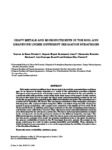Please use this identifier to cite or link to this item:
http://www.alice.cnptia.embrapa.br/alice/handle/doc/1015560| Title: | Heavy metals and micronutrients in the soil and grapevine under different irrigation strategies. |
| Authors: | OLIVEIRA, V. de S.  LIMA, A. M. N.   MENDES, A. M. S.   BASSOI, L. H.   PEREIRA, G. E.   |
| Affiliation: | VANESSA DE SOUZA OLIVEIRA, Graduanda da UNIVASF; AUGUSTO MIGUEL NASCIMENTO LIMA, Graduando da UNIVASF; ALESSANDRA MONTEIRO SALVIANO MENDES, CPATSA; LUIS HENRIQUE BASSOI, CPATSA; GIULIANO ELIAS PEREIRA, CNPUV. |
| Date Issued: | 2015 |
| Citation: | Revista Brasileira de Ciência do Solo, Viçosa, MG, v. 39, n. 1, p. 162-173, 2015. |
| Description: | Soils under natural conditions have heavy metals in variable concentrations and there may be an increase in these elements as a result of the agricultural practices adopted. Transport of heavy metals in soil mainly occurs in forms dissolved in the soil solution or associated with solid particles, water being their main means of transport. In this context, the aim of this study was to evaluate the heavy metal and micronutrient content in the soil and in the grapevine plant and fruit under different irrigation strategies. The experiment was carried out in Petrolina, PE, Brazil. The treatments consisted of three irrigation strategies: full irrigation (FI), regulated deficit irrigation (RDI), and deficit irrigation (DI). During the period of grape maturation, soil samples were collected at the depths of 0-10, 10-20, 20-40, 40-60, and 60-80 cm. In addition, leaves were collected at the time of ripening of the bunches, and berries were collected at harvest. Thus, the heavy metal and micronutrient contents were determined in the soil, leaves, and berries. The heavy metal and micronutrient contents in the soil showed a stochastic pattern in relation to the different irrigation strategies. The different irrigation strategies did not affect the heavy metal and micronutrient contents in the vine leaves, and they were below the contents considered toxic to the plant. In contrast, the greater availability of water in the FI treatment favored a greater Cu content in the grape, which may be a risk to vines, causing instability and turbidity. Thus, adoption of deficit irrigation is recommended so as to avoid compromising the stability of tropical wines of the Brazilian Northeast. |
| Thesagro: | Uva Solo Metal pesado Irrigação Disponibilidade de Água Nutriente |
| Keywords: | Micronutriente Grape Water availability |
| DOI: | 10.1590/01000683rbcs20150284 |
| Type of Material: | Artigo de periódico |
| Access: | openAccess |
| Appears in Collections: | Artigo em periódico indexado (CPATSA)  |
Files in This Item:
| File | Description | Size | Format | |
|---|---|---|---|---|
| Bassoi2015.pdf | 455,94 kB | Adobe PDF |  View/Open |









